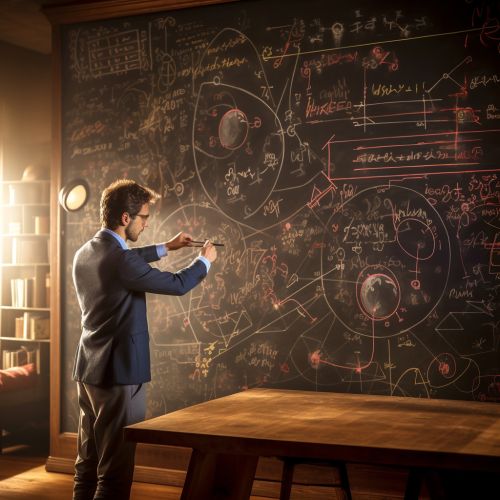Theory of everything
Introduction
The Theory of Everything is a hypothetical framework in theoretical physics that fully explains and links together all known physical phenomena. Initially introduced in the 20th century, the term was popularized by physicists like Stephen Hawking and John Ellis. The pursuit of a ToE is one of the most prominent goals in the field of particle physics.


Historical Background
The concept of a ToE evolved from the unification of forces in physics. The first successful unification was James Clerk Maxwell's electromagnetic theory, which unified electricity and magnetism in the 19th century. This was followed by the unification of the weak nuclear force and electromagnetic interaction in the Standard Model of particle physics.
Unification of Forces
The unification of forces involves the idea that at high enough energies, the fundamental forces - electromagnetism, weak nuclear force, strong nuclear force, and gravity - were once a single, unified force. The first three forces are described within the framework of quantum mechanics, while gravity is described by general relativity.


Quantum Mechanics and General Relativity
Quantum mechanics and general relativity are the two main pillars of modern physics. However, they are fundamentally incompatible. Quantum mechanics describes the universe at the smallest scales, such as particles and atoms, while general relativity describes the universe at the largest scales, such as stars, galaxies, and the universe itself.
Quantum Gravity
Quantum gravity is a field of theoretical physics that seeks to reconcile the theories of quantum mechanics and general relativity, thereby creating a quantum theory of gravity. This is considered a significant step towards a ToE.


String Theory
string theory is a theoretical framework in which the point-like particles of particle physics are replaced by one-dimensional objects called strings. String theory describes how these strings propagate through space and interact with each other. It is one of the most promising candidates for a ToE.
Loop Quantum Gravity
Loop Quantum Gravity (LQG) is another significant approach to the problem of quantum gravity. It is a theory that attempts to merge quantum mechanics and general relativity. LQG is a rival theory to string theory.


Challenges and Criticisms
Despite the significant progress in theoretical physics, a complete ToE remains elusive. There are numerous challenges and criticisms, including the lack of experimental evidence, the mathematical complexity, and the so-called "landscape problem" in string theory.
Conclusion
The search for a Theory of Everything represents one of the most profound and challenging quests in theoretical physics. It is a journey that delves into the very heart of reality, seeking to uncover the ultimate laws that govern the universe.
